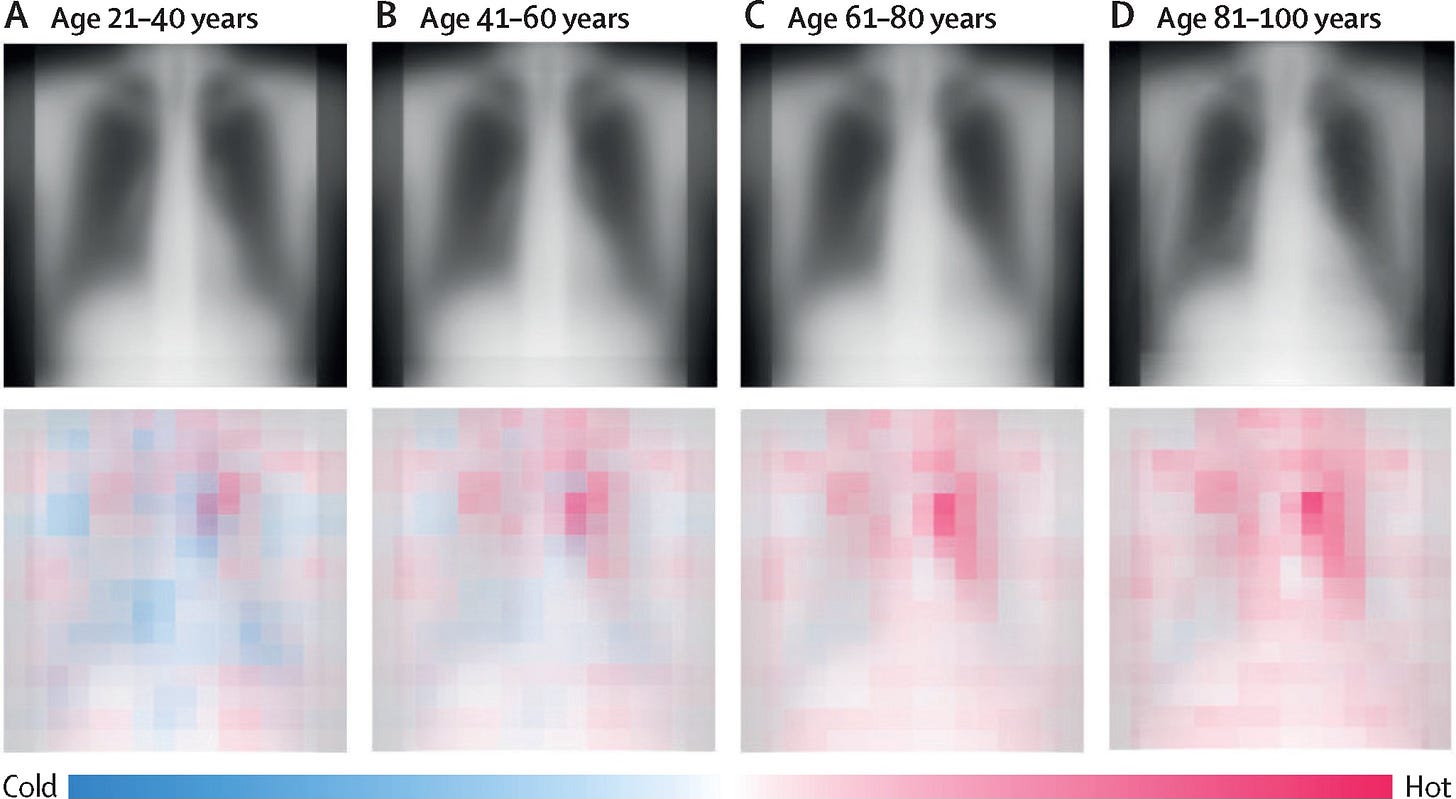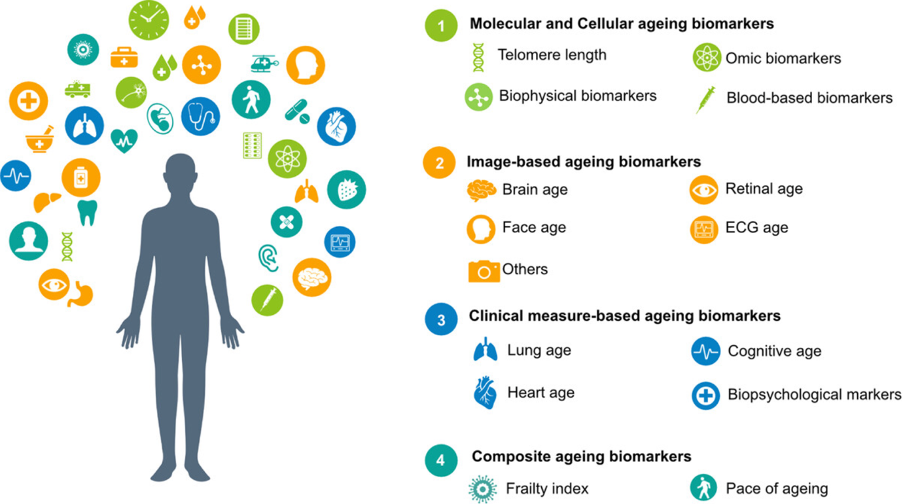The rising awareness of healthy aging along with the advancements in healthcare technology has driven extensive efforts towards addressing the gap between lifespan and healthspan.1 Additional factors including political and social considerations for super-aged societies have also led to rapid expansion of resources into aging-related research for future readiness in the context of population-wide longevity. However, to accelerate the development of longevity interventions, such as therapeutics and other strategies, identifying a reliable biomarker is critical to downstream pre-clinical and clinical validations. Currently, there is no established workflow and/or standards for aging-related biomarkers.2 For example, the process of aging may be attributed to a range of factors including genetics, exposures, experiences, among others. Moreover, people of same chronological age, which is defined by the time since birth, may experience completely different health outcomes.3 Thus, it is evident that aging is a highly heterogeneous process and that each person exhibits individual-specific state of longevity. In recent years, properly quantifying and assessing biophysiological aging process through the discovery of aging biomarkers have been prioritized.3

Standardizing and Discovering Biomarkers of Aging
Though extensive efforts have been put into aging-related research, standards for biomarker discovery are not yet established. In a study published in The Journals of Gerontology: Series A, Butler et al. proposed a series of criteria to define biomarkers of aging.3,4 These guidelines have also been adopted by the American Federation for Aging Research (AFAR).3,4
1. The biomarker of aging should be broadly applicable to age-sensitive tests in various domains. This marker should also be more accurate than chronological age.
2. The marker should measure the aging process and its mechanisms, instead of the effects of diseases.
3. The measurement of the biomarker can be repeatedly tested without any harms.
Multiple approaches to identify actionable aging biomarkers have been developed. The conventional approaches include correlating open access large datasets to chronological age and assessing longitudinal datasets from specific individuals.5,6 Aside from these conventional strategies, regression models, machine learning, and deep learning have also been deployed for biomarker discovery.3
Furthermore, other AI-powered strategies have also been harnessed to identify and pinpoint actionable biomarkers. In a recent study published in The Lancet Healthy Longevity, Mitsuyama et al. harnessed AI-driven models to predict age from chest radiography.7 The emergence of AI may potentially accelerate the identification of relevant and reliable biomarkers of aging. These markers may be categorized into different types ranging from cellular markers to clinical phenotypes.
Credit: Mitsuyama, et al. (2023). The Lancet Healthy Longevity.7
Categorizing Biomarkers of Aging3
Biomarkers of aging can be generally categorized into different categories described below. Additional markers spanning from clinical measurements (e.g. cognitive age, heart age, lung age) to composite markers (e.g. frailty index) have also been explored.3 Though these markers have provided insights into biological age, it is important to address variations arising from different populations. For example, the predictability of some markers may be less accurate within a specific demographic.3,5
Credit: Chen, et al. (2023). MedComm–Future Medicine.3
Molecular and Cellular Biomarkers
Telomere length
Omics: epigenetics, transcriptomics, proteomics, etc
Biophysical Biomarkers
Cell mechanics
Tissue rigidity
Blood-based Biomarkers
Quantitative/morphological assessments on red/white blood cells
Inflammation
Immunosenescence
Image-based Biomarkers
Brain age
Retinal age
MRI-based markers
Currently Available Biomarker Test Kits
A few examples of home kits for longevity biomarkers are discussed below.
GlycanAge8
Background: Glycans are sugar molecules that modify proteins. Biological age is determined from glycan responses to lifestyle.
How it works?
Receive test-kits in mailbox
Sample with a finger prick test
Results in 3-5 weeks
Consult with specialists regarding results
AgeRate9
Background: Measuring over 50,000 epigenetic markers to provide a comprehensive results on aging.
How it works?
Collect small blood sample with at-home kit
Mail in for comprehensive epigenetic analysis
Personalized report with recommended longevity plans
In the next blog post series, we will discuss therapeutics in the space of healthy aging and longevity.
References
Buxbaum, J. D., Chernew, M. E., Fendrick, A. M., & Cutler, D. M. (2020). Contributions Of Public Health, Pharmaceuticals, And Other Medical Care To US Life Expectancy Changes, 1990-2015: Study examines the conditions most responsible for changing US life expectancy and how public health, pharmaceuticals, other medical care, and other factors may have contributed to the changes. Health Affairs, 39(9), 1546-1556.
Moqri, M., Herzog, C., Poganik, J. R., Justice, J., Belsky, D. W., Higgins-Chen, A., ... & Gladyshev, V. N. (2023). Biomarkers of aging for the identification and evaluation of longevity interventions. Cell, 186(18), 3758-3775.
Chen, R., Wang, Y., Zhang, S., Bulloch, G., Zhang, J., Liao, H., ... & Zhu, Z. (2023). Biomarkers of ageing: Current state‐of‐art, challenges, and opportunities. MedComm–Future Medicine, 2(2), e50.
Butler, R. N., Sprott, R., Warner, H., Bland, J., Feuers, R., Forster, M., ... & Wolf, N. (2004). Aging: the reality: biomarkers of aging: from primitive organisms to humans. The Journals of Gerontology Series A: Biological Sciences and Medical Sciences, 59(6), B560-B567.
Moqri, M., Herzog, C., Poganik, J. R., Ying, K., Justice, J. N., Belsky, D. W., ... & Ferrucci, L. (2024). Validation of biomarkers of aging. Nature medicine, 30(2), 360-372.
Levine, M. E., Lu, A. T., Quach, A., Chen, B. H., Assimes, T. L., Bandinelli, S., ... & Horvath, S. (2018). An epigenetic biomarker of aging for lifespan and healthspan. Aging (albany NY), 10(4), 573.
Mitsuyama, Y., Matsumoto, T., Tatekawa, H., Walston, S. L., Kimura, T., Yamamoto, A., ... & Ueda, D. (2023). Chest radiography as a biomarker of ageing: artificial intelligence-based, multi-institutional model development and validation in Japan. The Lancet Healthy Longevity, 4(9), e478-e486.
GlycanAge. https://glycanage.com
AgeRate. https://agerate.com



